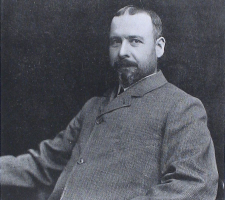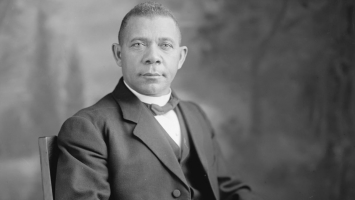Top 10 Interesting Facts about Gregor Mendel
German-speaking scientist Gregor Mendel is renowned for his pea plant experiments, which revealed how hereditary traits are passed down from generation to ... read more...generation. His research was disregarded at the time, and it wasn't until many years after his passing that he was acknowledged for his groundbreaking discoveries. Here are 10 interesting facts about Gregor Mendel, the life and accomplishments of the Father of Modern Genetics.
-
One of the most interesting facts about Gregor Mendel is he studied beekeeping and worked as a gardener in his childhood. Gregor Mendel was the second of Anton and Rosine Mendel's three children, and he was born on July 22, 1822, as Johann Mendel in the Austrian Empire settlement of Heinzendorf. The tiny farm on which the German-speaking Mendel family lived and worked had been their property for almost a century. Early in life, Johann lived in a rural area. In his youth, he worked as a gardener and took beekeeping classes. As a result, he was able to learn diverse farming methods and about different industries within this one. Many people are unaware of this aspect of his life, but it served as the cornerstone of what would eventually make his name renowned.
An intriguing tidbit about Gregor Mendel is that he reportedly conducted some research on the bees while caring for them. Additionally, he conducted testing on numerous tree and flower breeds in his yard. We may confidently assert that these actions significantly contributed to his success based on his explanations for where he received his fortune. Mendel was supposed to inherit the modest family farm as his father's only child, but he selected a different approach, preferring to enroll in the Altbrünn monastery as a novitiate of the Augustinian order, where he was given the name Gregor. Johann's academic abilities were noticed by the local priest, who convinced Johann's parents to enroll him in school when he was 11 years old.

Photo: https://www.researchgate.net/ 
Photo: https://link.springer.com/ -
Gregor Mendel began his education in Opava, where he later received an excellent high school diploma in 1840. His accomplishment allowed him to enroll at the University of Olomouc, which is now known as Palacky University. The second-oldest university in the Czech Republic was established in 1573 and is situated within the second-largest monument reserve in the nation. Sts. Cyril and Methodius Theological Faculty, Faculty of Medicine and Dentistry, Faculty of Arts, Faculty of Science, Faculty of Education, Faculty of Physical Culture, Faculty of Law, and Faculty of Health Sciences are the eight faculties that make up the University of the Philippines. The Olomouc University takes significant attempts to carry out its third function in society's outreach, which includes popularizing science. Gregor Mendel studied a variety of subjects there, including physics and philosophy.
Mendel had to tutor pupils to make ends meet because his family was unable to provide for him financially. To make ends meet, he instructed other students, but twice he struggled with severe depression and had to go home to heal. But he was a brilliant student, particularly in physics and mathematics. He took an additional year to finish the two-year curriculum in 1843 as a result of his illness.

Photo: https://www.upol.cz/ 
Photo: https://www.upol.cz/ -
Being the only son, the Mendel family anticipated that Johann would take over the family farm. Mendel chose to become a monk, nevertheless, most likely because it allowed him to escape poverty and finish his education without having to pay for it out of pocket. Mendel enrolled in a two-year philosophy program at the Philosophical Institute of the University of Olmütz after completing his Gymnasium (grammar school) studies in 1840. (Olomouc, Czech Republic). Mendel was one of Friedrich Franz's favorite students at the University of Olomouc. Franz taught physics and applied mathematics. Later, Franz and Mendel grew close. Johann enlisted in the Augustinian Order of St. Thomas in Brno, Moravia, at Franz's recommendation. At this location, he received the name Gregor, by which he is now well-known. This is also one of the most interesting facts about Gregor Mendel.
At the beginning, or at least until 1843, he went by the name Johann Mendel. After his birth, his parents gave him the name Johann. Mendel was nurtured in a rural environment in German-speaking Silesia after being born to a low-income family. Being the only boy in the family, he spent much of his time on the family farm with Theresa, his younger sister, and Veronica, his elder sister.

Photo: https://www.expii.com/ 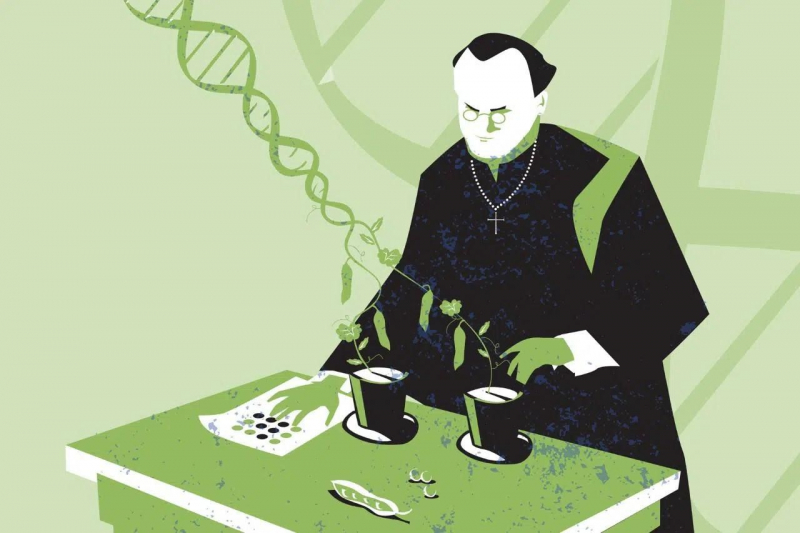
Photo: https://european-seed.com/ -
Sometimes humans don't get what humans want in life. This is demonstrated by Gregor Mendel, who made numerous unsuccessful attempts to obtain his teaching credential. Mendel worked as a substitute high school teacher in addition to receiving training to become a priest. He attempted the test to become a licensed high school teacher in 1850 but failed.
Mendel was instead sent to the University of Vienna for two years to take advantage of a new program of scientific teaching after failing an exam set by new regulations for teacher certification in 1850. Mendel spent his time in Vienna working with mathematical physicist Andreas von Ettinghausen and Austrian physicist Christian Doppler, just as he had done at Olmütz. Under the tutelage of botanist Franz Unger, a proponent of the cell theory and the developmental (pre-Darwinian) theory of life's evolution, he also studied the anatomy and physiology of plants as well as how to use a microscope. Mendel returned to the monastery in Brünn for the summer of 1853, and the following year he was again hired as a teacher, this time at the Brünn Realschule (secondary school), where he remained until he was chosen as abbot 14 years later. Despite the incident leading to a nervous breakdown and a second failure, he retook the teacher exam in 1856.

Photo: https://www.cambridge.org/ 
Photo: https://pixels.com/ -
Mendel was permitted in 1854 by Abbot Cyril Napp to organize a significant hybridization experimentation program at the monastery. The purpose of this program was to follow the inheritance of traits in subsequent generations of hybrid offspring. Although in rare circumstances some fertile hybrids did appear to not revert (the so-called "constant hybrids"), previous authorities had observed that progeny of fertile hybrids tended to revert to the originating species. They, therefore, concluded that hybridization could not be a mechanism used by nature to multiple species. However, plant and animal breeders have long demonstrated that crossbreeding can result in a wide variety of new species. The monastery's abbot, who was concerned about the monastery's future revenues from the wool of its Merino sheep due to competitive wool being provided from Australia, was particularly interested in the last issue.
Mendel decided to study the edible pea for his research (Pisum sativum), which is one of the most interesting facts about Gregor Mendel. He examined seven distinct traits in peas, such as plant height, seed color, and wrinkled or smoothness. Though Mendel never discovered it, the "particles of inheritance" in peas are distributed across seven pairs of chromosomes. Call it intuition or luck.

Photo: https://opentextbc.ca/ 
Photo: https://geneticliteracyproject.org/ -
Mendel bred pea varieties that were unique in one way, such as a plant with a tall stem and one with a small stem. He discovered that the outcome was a collection of tall plants rather than something in between. Mendel selected the edible pea (Pisum sativum) to study because of its many unique varieties, simplicity of cultivation and pollination control, and high rate of successful seed germination.
He examined the features of 34 cultivars between 1854 and 1856. He selected seven features, such as plant height (short or tall) and seed color, that were expressed distinctively to track the transfer of characters (green or yellow). These alternatives were referred to by him as contrasting characters or character pairs. He combined types that were different from one another, such as tall and short. The initial hybrid generation (F1) showed the traits of one variety but not the other. Mendel described these traits as one being dominant and the other recessive. However, the recessive trait returned in the countless offspring he produced from these hybrids (the second generation, F2), and the ratio of kids carrying the dominant gene to offspring carrying the recessive gene was very nearly 3 to 1. According to a study of the dominant group's offspring (F3), one-third of them were true breeders and the other two-thirds had the hybrid constitutions. As a result, the 3:1 ratio might be written as 1:2:1, which would indicate that 50% of the F2 generation was true-breeding and 50% was still a hybrid. Since they did not grow statistically significant populations or follow the various characters independently to determine their statistical relationships, Mendel's predecessors were unlikely to have discovered this important finding.

Photo: https://www.toppr.com/ 
Photo: https://www.mun.ca/ -
Mendel originally delivered his findings to the Brünn Natural Science Society in two distinct presentations in 1865. The next year, Verhandlungen des naturforschenden Vereines in Brünn, the society's magazine, published his article, "Experiments on Plant Hybrids." Despite being sent to many libraries and receiving reprints, it gained little notice. People who read it tended to get the conclusion that Mendel had just shown more convincingly what was previously commonly accepted—namely, those hybrid children revert to their originating forms. They failed to take into account the scope for variation and the evolutionary ramifications that his proof of trait recombination opened up.
It is unknown how many copies of Mendel's article he circulated, and it appears that he made little attempt to promote his work. Only eight of the forty reprints he ordered have been located. There are 15 sources known from the 19th century that mention Mendel concerning plant hybridization, excluding the journal that published his research. Few of these, most of which are quite brief, give a clear picture of his accomplishment.
After Mendel's passing and 35 years after the publication of his article, Hugo de Vries and Carl Correns rediscovered his discoveries in 1900, which is when the tremendous significance of his work was first understood. As a result, starting in the 1900s, his name gained notoriety.

Photo: https://sochapromendela.cz/ 
Photo: https://www.baitap123.com/ -
Mendel was chosen to lead his monastery as abbot in 1868. It is considered one of the most interesting facts about Gregor Mendel. Mendel was unable to continue his scientific work because of his declining eyesight and the amount of administrative work he had to do because of his position. As a result, he made the fascinating Gregor Mendel decision to dedicate his life to rise to the position of Abbot of his monastery. Mendel took his position as prelate seriously and recognized his obligation to the monastery for funding his academic pursuits.
Additionally, he got into a disagreement with the authorities over their attempt to tax religious institutions. His involvement in sociopolitical affairs may go unmentioned because it has nothing to do with his academics. Mendel fought for almost ten years when he was a monk to get the new taxation laws that were imposed on monasteries repealed. He said that such a requirement violated the constitution. Mendel passed away before the conflict was resolved, therefore he did not live long enough to see the outcome of this battle. His final years were uncomfortable because he had the Bright disease, which is an inflammation of the kidney's urine-producing processes. Gregor Mendel passed away on 6 January 1884 in Brno. He was 61 years old.
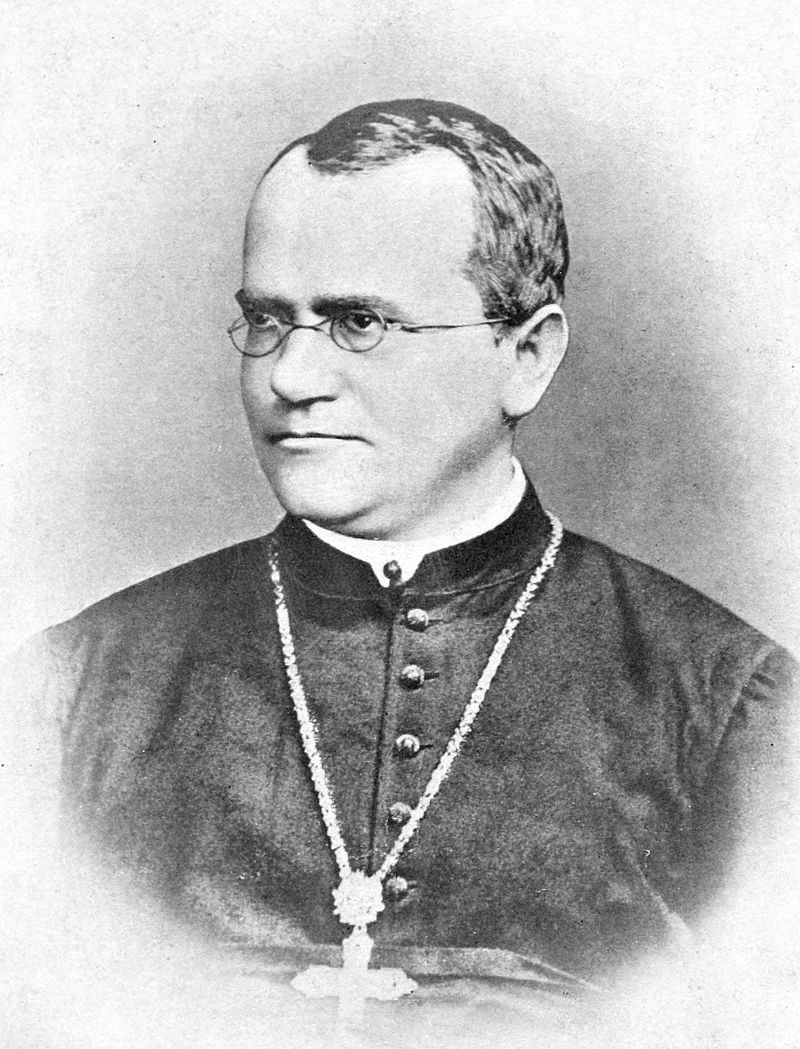
Photo: https://www.vaticanobservatory.org/ 
Photo: https://www.britannica.com/ -
The process by which a kid inherits genetic information from a parent is known as inheritance. The fact that the kids resemble their parents is due to inheritance, which underlies the entire process of heredity. Simply put, this indicates that individuals of the same family share traits as a result of inheritance.
Gregor Mendel uncovered the basic principles of inheritance through his study of pea plants. He concluded that genes are inherited from each parent as separate, paired units. Mendel observed how parental genes separated and if they showed up as dominant or recessive qualities in the children. He was aware of the mathematical patterns passed down from one generation to the following. Typically, Mendel's Laws of Heredity are phrased as follows:
- The Law of Segregation: A gene pair determines each inherited trait. So that each sex cell only contains one of a pair of parental genes, parental genes are arbitrarily distributed to the sex cells. Thus, when sex cells combine to form offspring during fertilization, they receive one genetic allele from each parent.
- The Law of Independent Assortment: Different qualities' genes are grouped independently of one another so that inheriting one trait does not affect inheriting another.
- The Law of Dominance states that an organism with two possible gene variants will express the dominant form.
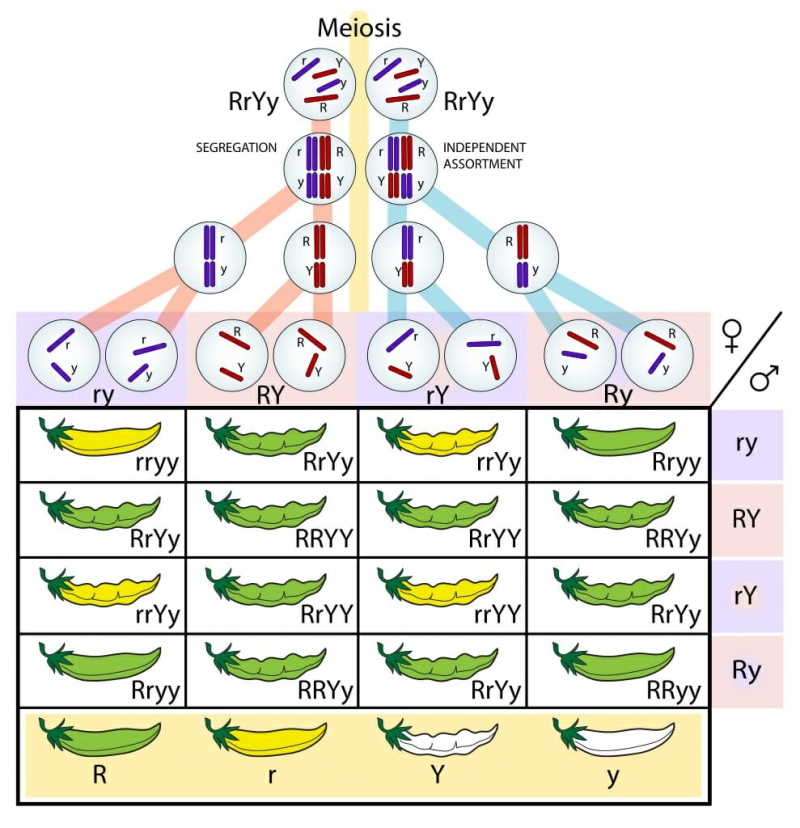
Photo: https://biologydictionary.net/ 
Photo: https://ib.bioninja.com.au/ -
Nowadays, genetics is covered in one or two lessons in every biology course. Simply put, "genetics" is the study of how genes (the transmission of traits from one generation to the next) function. The availability of studies from decades ago has made this easier now.
Gregor Mendel is a pioneer in this discipline as well as one of the researchers. Today's majority of scientists rely their work on his ground-breaking studies on plants to find answers to problems about heredity. Mendel's prominence skyrocketed after his theories were rediscovered. Mendel's theories are the foundation of traditional genetics, along with Nobel Prize winner Thomas Hunt Morgan's 1915 Boveri-Sutton chromosomal theory of heredity. The present synthesis of evolutionary biology was created in the 1930s and 1940s as a result of the fusion of Darwin's natural selection theory and Mendel's theories. Since he was the first to uncover how traits are passed from parents to their children, Gregor Mendel is recognized as the "father of modern genetics" and is credited with creating the genetics field as we know it today.

Photo: https://slideplayer.com/ 
Photo: https://kukufm.com/






















